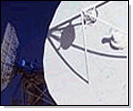
| 
| Latest Business news on mobile: sms BIZ to 7333 |

Home > Business > Business Headline > Budget 2005-06 > Report
Telecom: Ringing in good times
February 24, 2005 07:15 IST
 The cellular telephony segment has emerged as the fastest growing segment in the Indian telecom industry. In fact, the segment achieved a landmark in FY03 when, for the first time, more cellular subscribers were added than fixed line subscribers. A slew of tariff reduction in the past 2 years has helped the segment to gain in popularity. The cellular segment is playing an important role in the industry by making itself available in the rural and semi urban areas where tele-densities are the lowest and where fixed line services will take some time to penetrate deep because of high capital investments required to build a network. | | Key Positives | | | An emerging Sector: The telecom sector has been one of the fastest growing sectors in the Indian economy in the last 3 years. This has been witnessed due to strong competition that has brought down tariffs as well as simplification of policy environment that has promoted healthy competition among various players. Due to this reason, telecom density in the country has risen to 8.8% at the end of January 2005, from 3.6% in March 2001. | | It's ringing mobile: The mobile sector alone has been growing rapidly and has emerged as the fastest growing market in the whole worlds. Currently over 38 m (46% of the total subscriber base), this sector is expected to reach a size of nearly 75 m subscribers by FY06. | | Consolidation picking up: The government has eased the rules regarding inter circle and intra circle mergers. This has led to a slew of mergers and acquisitions in the recent past. Also as the sector is moving closer to maturity, further consolidation is a reality and this will lead to the survival of more profitable players in this segment. | | Broadband push: In order to further promote the use of Internet in the country the government is taking proactive steps to develop this sector with the help of the various players in this segment. Hence for this purpose the use of broadband technology is being mooted and this will go a long way in improving the productivity of the Indian economy as well as turn out to be the next big opportunity for telecom companies after the mobile communications segment. |
| | | Key Negatives | | | Regulatory environment still evolving: The regulatory environment, though has improved, is still perplexing. The tariffs in this sector are still regulated to an extent by the Telecom Regulatory Authority of India (TRAI). This impedes free market forces from deciding on tariffs. | | Highly taxed sector: The COAI (Cellular Operators Association of India) has indicated that the telecom sector, especially the cellular services segment, continues to pay very high duties and levies. The association has also indicated that due to the high rates of duties and levies and falling ARPUs, cellular service providers are not in a position to fund expansion and enter in to the relatively lesser-serviced rural areas. Currently, the sector is paying duties and levies under various heads including annual license fees, spectrum charges and access deficit charge (this has been partly reduces off late). In addition to the above, significant levies are also imposed on the industry on account of sales tax, service tax and import duties on handsets and other telecom hardware. As a matter of fact, a report from TRAI states that the burden on the sector on account of access deficit charge, spectrum charges and license fees is to the tune of 25%. This excludes the burden of sales tax and the effects of other levies like service tax and import duties. |
|

This is part of Equitymaster's Budget 2005-06 series. Equitymaster.com is one of India's premier finance portals. The Web site offers a user-friendly portfolio tracker, a weekly buy/sell recommendation service and research reports on India's top companies.
Budget 2005-06: Complete Coverage

| 
| 
|